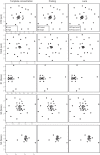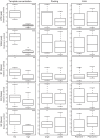Evaluating bias of illumina-based bacterial 16S rRNA gene profiles
- PMID: 25002428
- PMCID: PMC4178620
- DOI: 10.1128/AEM.01451-14
Evaluating bias of illumina-based bacterial 16S rRNA gene profiles
Abstract
Massively parallel sequencing of 16S rRNA genes enables the comparison of terrestrial, aquatic, and host-associated microbial communities with sufficient sequencing depth for robust assessments of both alpha and beta diversity. Establishing standardized protocols for the analysis of microbial communities is dependent on increasing the reproducibility of PCR-based molecular surveys by minimizing sources of methodological bias. In this study, we tested the effects of template concentration, pooling of PCR amplicons, and sample preparation/interlane sequencing on the reproducibility associated with paired-end Illumina sequencing of bacterial 16S rRNA genes. Using DNA extracts from soil and fecal samples as templates, we sequenced pooled amplicons and individual reactions for both high (5- to 10-ng) and low (0.1-ng) template concentrations. In addition, all experimental manipulations were repeated on two separate days and sequenced on two different Illumina MiSeq lanes. Although within-sample sequence profiles were highly consistent, template concentration had a significant impact on sample profile variability for most samples. Pooling of multiple PCR amplicons, sample preparation, and interlane variability did not influence sample sequence data significantly. This systematic analysis underlines the importance of optimizing template concentration in order to minimize variability in microbial-community surveys and indicates that the practice of pooling multiple PCR amplicons prior to sequencing contributes proportionally less to reducing bias in 16S rRNA gene surveys with next-generation sequencing.
Copyright © 2014, American Society for Microbiology. All Rights Reserved.
Figures




References
-
- Wagner A, Blackstone N, Cartwright P, Dick M, Misof B, Snow P, Wagner GP, Bartels J, Murtha M, Pendleton J. 1994. Surveys of gene families using polymerase chain reaction: PCR selection and PCR drift. Syst. Biol. 43:250–261
Publication types
MeSH terms
Substances
Grants and funding
LinkOut - more resources
Full Text Sources
Other Literature Sources

